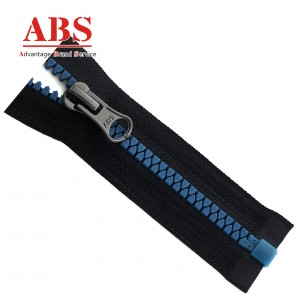Introduction to Zipper Materials: Plastic and Metal
Zippers are a fundamental component in various applications, from fashion garments to outdoor gear. The two primary materials used for zippers are plastic and metal, each offering distinct characteristics and cost implications. Understanding these differences is essential for manufacturers and suppliers in making informed decisions.
Cost Factors of Plastic Zippers
Material Costs
Wholesale Plastic Zippers are primarily made from molded polymer materials which are generally cheaper to produce than metals. The raw material cost for plastic is lower, contributing to a more affordable unit price for plastic zippers. Additionally, plastic zippers are less expensive to dye and can be produced in a wide array of bright colors without significant cost increases.
Production Costs
The production process for plastic zippers is less labor-intensive and more energy-efficient than for metal zippers. Injection molding, the primary method of producing plastic zippers, allows factories to create high volumes with relative ease, reducing the per-unit cost.
Cost Factors of Metal Zippers
Material Costs
Metal zippers are typically made from zinc, brass, or nickel. These materials tend to have higher costs compared to plastics, influencing the overall price of metal zippers. The sourcing of metals can fluctuate based on market demand and geopolitical factors, affecting the cost stability.
Manufacturing Costs
The manufacturing of metal zippers involves more intricate processes such as casting and electroplating. These steps require additional labor and energy, thereby increasing the production costs. Moreover, quality control measures for metal zippers are often more stringent, adding to the cost.
Comparing Manufacturing Processes
Plastic Zipper Production
Plastic zippers are produced using injection molding, allowing for quick and efficient mass production. Factories often have the capacity to produce millions of units with high consistency and minimal waste, which is economically beneficial.
Metal Zipper Production
Metal zippers require casting for teeth and sliders, followed by processes such as polishing, brushing, and electroplating. These steps add complexity and time to the manufacturing process, contributing to the higher overall cost.
Market Price Trends for Plastic and Metal Zippers
Market trends indicate that plastic zippers have remained relatively stable in price due to consistent raw material availability and advancements in production technology. In contrast, metal zippers experience more price variability due to fluctuations in metal markets and the higher energy demands of production.
Durability and Lifecycle Costs
Plastic Zippers
Plastic zippers are lightweight, corrosion-resistant, and suitable for applications where flexibility and weather resistance are necessary. While their initial cost is lower, they may wear out faster than metal zippers under high stress.
Metal Zippers
Metal zippers are favored for their strength and durability, making them ideal for heavy-duty applications. Despite a higher upfront cost, the long-term durability of metal zippers can make them more cost-effective over time, particularly in demanding environments.
Aesthetic Value vs. Functional Costs
While plastic zippers can be produced in numerous colors, offering design flexibility, metal zippers provide a classic look that is often perceived as more luxurious. This aesthetic appeal can justify the higher price of metal zippers in certain fashion-forward applications.
Application-Specific Cost Considerations
Different applications dictate the choice between plastic and metal zippers. For instance, outdoor and sportswear often benefit from the use of plastic zippers due to their lightweight and resistant properties. Meanwhile, leather jackets and jeans typically use metal zippers for their strength and aesthetic appeal.
Environmental Impact and Related Costs
Sustainability of Plastic Zippers
Plastic zippers have a lower environmental footprint during production but pose environmental concerns due to plastic waste. Recycling initiatives and bioplastics are emerging as solutions to mitigate these impacts.
Sustainability of Metal Zippers
Metal zippers, while energy-intensive to produce, are more readily recyclable. The recycling of metals can offset some of the environmental costs associated with their production, offering a sustainable alternative.
Conclusion: Evaluating Cost-Effectiveness
The choice between plastic and metal zippers involves a careful evaluation of cost, durability, aesthetic requirements, and environmental impact. Each type offers distinct advantages that can influence their overall cost-effectiveness.
ABS Zipper Provide Solutions
ABS Zipper offers comprehensive solutions for selecting the optimal zipper type for your needs. By evaluating factors such as application, durability, and aesthetic value, ABS Zipper collaborates with manufacturers and suppliers to offer tailored solutions that optimize cost-efficiency and performance. With a focus on sustainability, we provide options that balance functional needs with environmental responsibility. 











